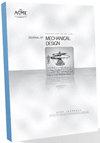设计融合:整合生成模型,丰富概念设计
IF 2.9
3区 工程技术
Q2 ENGINEERING, MECHANICAL
引用次数: 0
摘要
概念设计是产品设计和开发的一个关键阶段,包括用户需求探索和知情解决方案生成。最近,生成模型凭借其强大的内容生成能力被应用于概念设计,为设计师的构思提供支持。然而,生成模型的生成过程缺乏透明度,生成的解决方案也比较肤浅,这些都制约了它们在复杂的概念设计任务中的表现。在本研究中,我们首先介绍了一种将生成模型与经典设计理论相结合的概念设计生成方法。该方法基于设计过程和设计属性对概念设计任务进行分解,并使用 "谁、什么、哪里、何时、为什么、如何"(5W1H)方法、"功能-行为-结构"(FBS)模型和 "康成工程学"(Kansei Engineering)指导生成模型通过多步推理生成概念设计解决方案。然后,我们介绍了一个使用思维导图布局来可视化多步骤推理的互动系统,名为 DesignFusion。这使设计人员能够跟踪生成过程,并控制每个推理步骤的输入/输出。两项用户研究表明,我们的方法大大提高了生成的设计方案的质量,并丰富了设计师在人机共创中的体验。本文章由计算机程序翻译,如有差异,请以英文原文为准。
DesignFusion: Integrating Generative Models for Conceptual Design Enrichment
Conceptual design is a pivotal phase of product design and development, encompassing user requirement exploration and informed solution generation. Recent generative models with their powerful content generation capabilities have been applied to conceptual design to support designers' ideation. However, the lack of transparency in their generation process and the shallow nature of their generated solutions constrain their performance in complex conceptual design tasks. In this study, we first introduce a conceptual design generation approach that combines generative models with classic design theory. This approach decomposes the conceptual design task based on design process and design attributes, and uses the Who, What, Where, When, Why, How (5W1H) method, Function-Behavior-Structure (FBS) model, and Kansei Engineering to guide generative models to generate conceptual design solutions through multi-step reasoning. Then we present an interactive system using a mind-map layout to visualize multi-step reasoning, called DesignFusion. This empowers designers to track the generation process and control inputs/outputs at each reasoning step. Two user studies show that our approach significantly enhances the quality of generated design solutions and enriches designer experience in human-AI co-creation.
求助全文
通过发布文献求助,成功后即可免费获取论文全文。
去求助
来源期刊

Journal of Mechanical Design
工程技术-工程:机械
CiteScore
8.00
自引率
18.20%
发文量
139
审稿时长
3.9 months
期刊介绍:
The Journal of Mechanical Design (JMD) serves the broad design community as the venue for scholarly, archival research in all aspects of the design activity with emphasis on design synthesis. JMD has traditionally served the ASME Design Engineering Division and its technical committees, but it welcomes contributions from all areas of design with emphasis on synthesis. JMD communicates original contributions, primarily in the form of research articles of considerable depth, but also technical briefs, design innovation papers, book reviews, and editorials.
Scope: The Journal of Mechanical Design (JMD) serves the broad design community as the venue for scholarly, archival research in all aspects of the design activity with emphasis on design synthesis. JMD has traditionally served the ASME Design Engineering Division and its technical committees, but it welcomes contributions from all areas of design with emphasis on synthesis. JMD communicates original contributions, primarily in the form of research articles of considerable depth, but also technical briefs, design innovation papers, book reviews, and editorials.
 求助内容:
求助内容: 应助结果提醒方式:
应助结果提醒方式:


